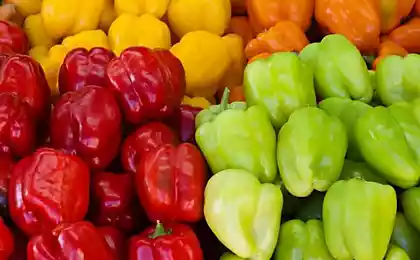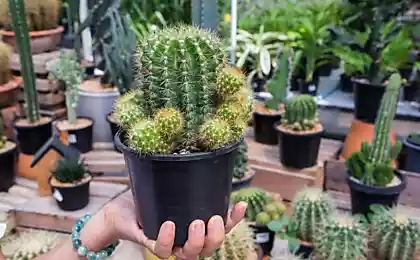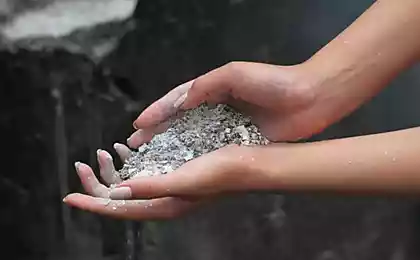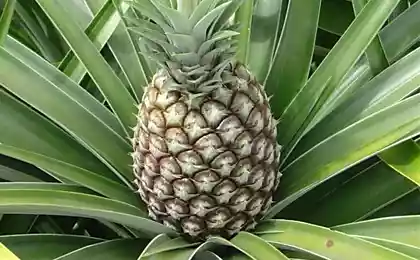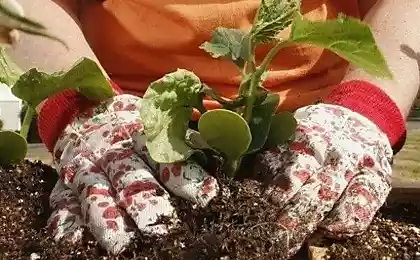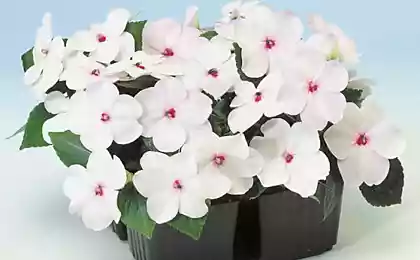918
How to grow potted peppers
Room pepper is actually not pepper (Piper) from the Pepper family (Piperaceae). It's the Capsicum (Capsicum) from the Nightshade family (Solanaceae). However, other known vegetable peppers (bell, sweet, bitter) is actually the capsicums. Pepper is the from which the spice (peas and ground, fragrant, pink, white). The birthplace of capsicum consider the tropical regions of Mexico and Guatemala, where the peppers were domesticated in ancient times. Nowadays the plant is widely spread over all the continents.
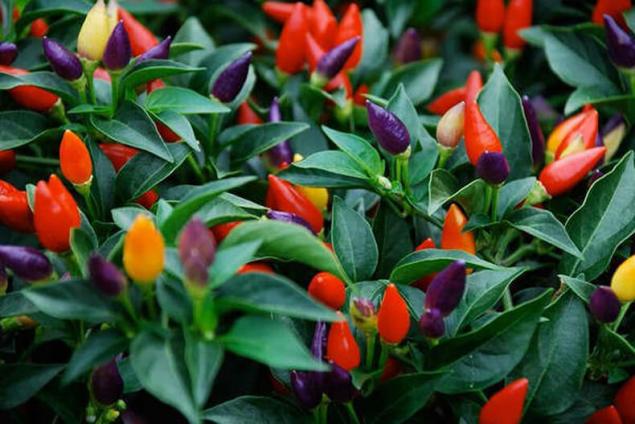
Among the plants of the genus are perennials, bushes and shrubs. A common culture of some capsicum, the most popular of them is capsicum peppers (Capsicum annuum). It's funny, but not enough that it's not a pepper, he's got no pods. In the Botanical sense the fruit is nothing like the berries as related capsicum tomato, eggplant, potatoes and nightshade. Varieties of "pepper" a lot, divide them into two groups – sweet and bitter. Bitter and spicy taste depends on the content of the alkaloid capsaicin.
Capsicum grows well in the open ground in Ukraine and Moldova, are cultivated in the South of Russia and in the republics of Central Asia. Dwarf varieties often called ornamental and grown as a houseplant. In home ornamental pepper is able to live for several years, annually blossoming and giving fruit. But not all know it and, most often, the plant is thrown away after falling off the fruit.
Bushes potted capsicum compact, well-branched, their height is usually from 20 to 50cm. The leaves are ovate, elongated to varying degrees, are lanceolate.
Flowers and then fruits appear in the branching of the stem. Flowers solitary, paired or assembled in bundles, pentamerous. Corolla white, yellow or purple. Flowers are capable of self-pollination and cross-pollination that makes it easy to get the fruit under ambient conditions.
Shape, color and size of the pepper depends on the variety. They are usually red, yellow or purple. The taste is bitter.
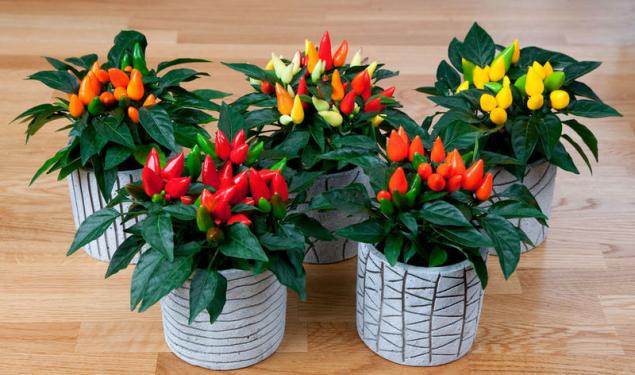
Ornamental capsicum in the period of fruit ripening is often decorated with small bright fruit. Modern hybrids potted peppers can be dark purple or variegated foliage, the peppers can hide under the leaves or climb up above the Bush like small horns. There are even varieties that have fruits are highly elongated in length and twists. One plant fruit can be different colors depending on the degree of maturation.
Potted pepper plant is unpretentious, easy to maintain, flowering and fruiting in the home without any problems.
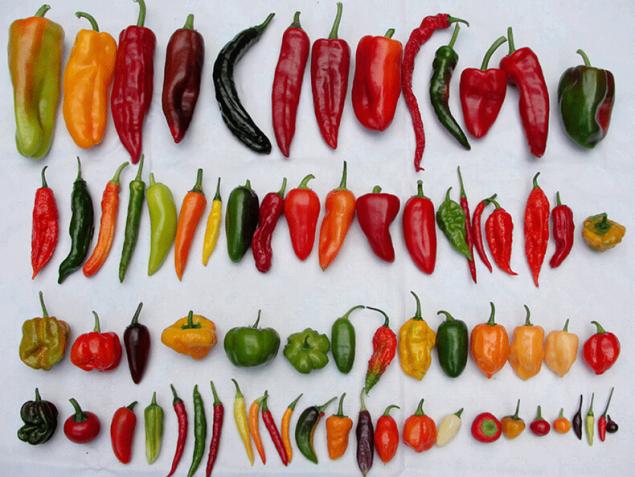
POPULAR VARIETIES OF PEPPERS
Dwarf varieties for growing in the home different the same variety as the variety for open ground. In fact, at home you can grow almost any pepper, they differ only in the size of the Bush and the fruit. Here are some popular varieties:
Capsicum Rainbow
Spectacular, elegant pepper: a little round, with a slightly elongated "beak" peppers as they Mature are full of different colors.Initially, the pods have a purple hue, as the ripening changes the color through white, yellow, orange to red. Plant height 20-25 cm Leaves are dark green.
Capsicum Aji Brazilian pumpkin
A variety of stunning beauty. The plant is covered with small glossy "pumpkins", quite sharp and thick. The size of the fetus is about 3 cm in diameter. Mature fruits have a beautiful "tomato" red color.
Capsicum Medusa
Capsicum Medusa. This variety of pepper is an interesting location, and shape of the fruit on the Bush, resembling the tentacles of jellyfish. Compact shrub, peppercorns have a pungent taste and are used in culinary dishes preparations. Mature fruits are painted in bright red color.
Capsicum Black Pearl - the world's first "chernolistnaya" pepper.
The leaves are first green, later black, shiny. The fruits resemble slightly elongated pea also black. Ripen, they turn dark red colour.
Capsicum Salsa Orange
Capsicum Salsa Orange ornamental pepper variety for growing in pots. Plant height 15 cm fruit – green, then orange. The vegetation period before biological maturity is 85-90 days. The value of this variety of pepper is highly decorative.
Capsicum Poinsettia ornamental pepper variety to grow at home or in pots outdoors. Pods 7-8 cm long, conical, the tip can bend a little hook. Plant height 30-40 cm very decorative pods peresvety in red through the milk. The variety is precocious, 70-80 days of the growing season until biological maturity.
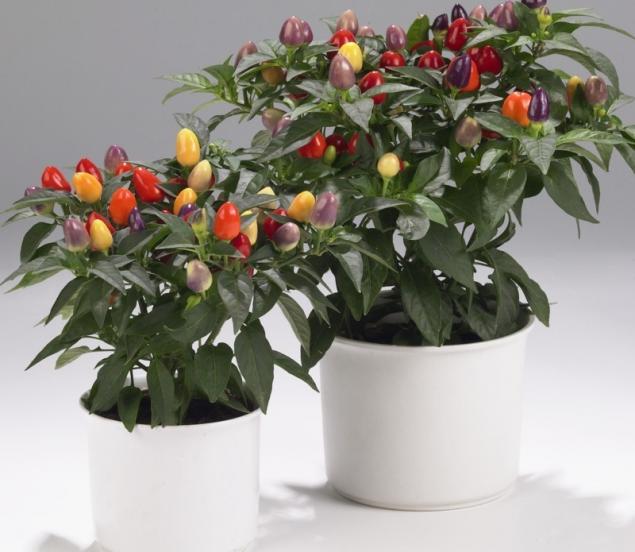
Capsicum Masquerade
Capsicum Masquerade ornamental pepper with purple, cream, orange, and then red fruits. Depending on what kind of sharpness I want to try, and this color can disrupt. Purple — a little tingling, red — hot. Suitable for growing on the windowsill as an indoor pepper. Simultaneously, the plants are pods all colors.
Capsicum Basket of Fire ornamental varieties of hot pepper for growing in pots and hanging planters. The fruit is initially pale yellow and later change color to red via orange. Small pods 2 to 4 cm, acute-conical. The variety is very decorative and practical, the pods could be used in the canning of vegetables, add to dishes or to dry.
Capsicum Tepin. The wild small-fruited pepper with fruits with a blast of urgency. "Cowboy berry", these fruitlets ate the cowboys, sitting on duty, to stay awake. The leaves are small, centimeter fruitlets red. This variety, like Mini, irresistible on the window sills.
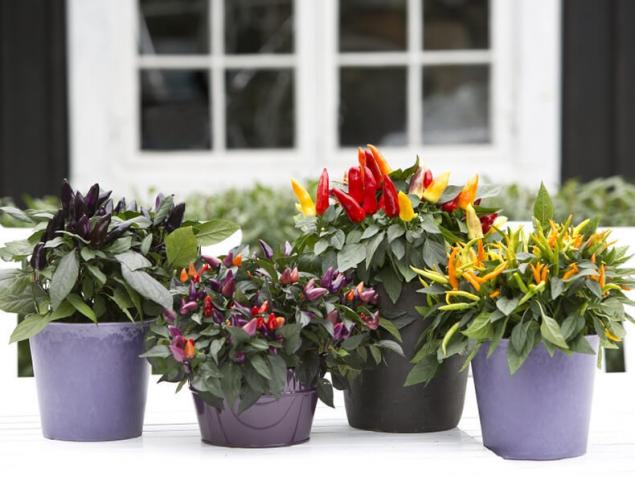
THE CAPSICUM (PEPPER ROOM), TIPS ON CARE
Like any tropical plant potted peppers love heat and lots of sunlight.
Illumination. The capsicum requires full sun, at least 4 hours a day of direct sun. Grows well in southern and Western Windows. If the plant is dark, and leaves on it a little, it is poorly flowering and fruiting. In the summer heat from direct sunlight should be protected from direct sunlight, as sunburns are possible.
Temperature. In spring and in summer 20-25 °C. If pepper winters, then it needs cool the contents to 15 °C. Very useful for this culture daily fluctuations in temperature. That night was cooler by 5-7 degrees is best to stand on the porch or balcony.
Watering. The capsicum in the summer abundantly watered as the drying of the upper layer of the substrate, during the winter in cold areas, watering is rare. Water is preferably used at room temperature.
Soil. Soil mixture for cultivation of capsicum lightweight, easy neutral. It may consist of 1 part leaf humus, 1 part humus, 1 part garden soil and 1/2 part sand.
The humidity of the air. Does not really matter, but spraying it reacts well.
Fertilizer. It is useful to feed complex fertilizer, from spring to autumn, every two weeks. In winter, do not fertilize. Remember that when planning to use the peppers in your food, you should not get too carried away with fertilizers.
Pollination. The fruits are well tied and without cross-pollination, just shake the pot with the pepper. Artificial pollination increases the number of ovaries. The transfer of pollen from one flower to another using a soft brush or cotton ball allows to obtain higher yields. You should know that the peppers easily cross-pollinated. So if you have one window grows a few different varieties, it is not correct. What the harvest will gather no — one knows.
Trim. Pruning is necessary when growing as perennials. Old cut peppers in late winter or early spring to about half the height of the stems. As is often the capsicum are sown in the spring from seed, and in the fall throw, it doesn't cut.
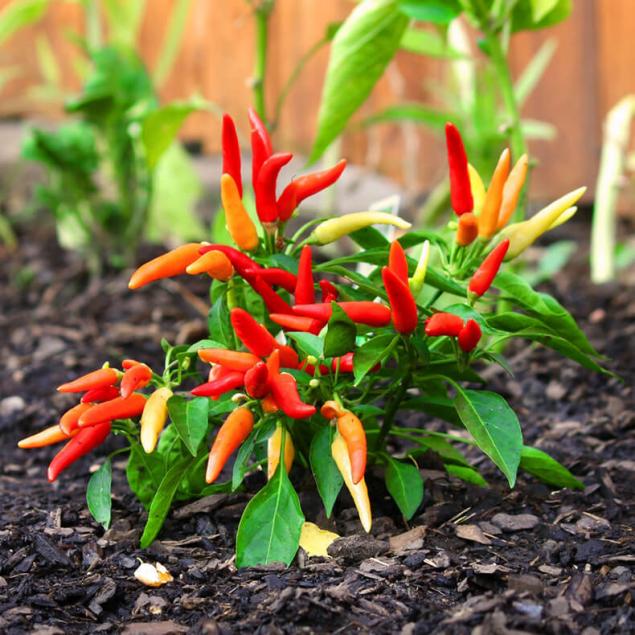
A period of rest. In connection with the decrease in daylight peppers comes from a forced rest period. If the lighting is artificial, flowering and fruiting can continue without interruption.
Transplant. Old last year capsicums are transplanted into fresh soil. Grown from seed as annuals are transplanted once after planting in a separate pot, and then, if necessary, rolled over into a bigger tank.
Reproduction. Room peppers are propagated by seeds and cuttings.
The seeds are sown early, in February. The crops are kept warm in the South window. For germination requires a temperature of 22-25°C. once the seedlings have appeared, the temperature was lowered to 16-20°C.
To dive is possible, but not necessarily. When swordplay seedlings stop its development. Best to sow in individual cups or after appearance of two leaves carefully raspikirovat without damaging the roots in a separate container.
The growth of pepper transplant in a larger pot method of handling and taking care not to damage shallow roots. It is believed that the size of the pot should roughly fit the size of the crown of the plant.
Collect seeds from fully ripe fruit and sow them, of course, possible. They well remain viable. But the result is not always possible to predict. First, if on the bag of purchased seed was the designation F1, it is a hybrid of 1st generation and "descendants" will be similar to the unknown initial variety. Second, if the window or in the yard in the summer has grown more and other peppers that might occur cross-pollination, which will give an unknown result.
How to determine a good day for plantingTOP 10 most popular perennials for the garden
If the seeds are beloved varieties, can not buy, it is possible to take cuttings from adult plants and root them in a mixture of soil and sand (1:1). Best rooted side shoots with a "heel". For successful rooting requires warm soil and moisture. The cuttings covered with foil and the temperature was raised to 20-25 degrees.
Diseases and pests. Typical capsicum pests are mealybugs. Excessive moisture of the substrate, cool content and the recessed landing of the pepper develops root rot. In dry and warm air pepper amaze spider mites and aphids.published
Source: greendom.net/catalog/k/438-capsicum.html

Among the plants of the genus are perennials, bushes and shrubs. A common culture of some capsicum, the most popular of them is capsicum peppers (Capsicum annuum). It's funny, but not enough that it's not a pepper, he's got no pods. In the Botanical sense the fruit is nothing like the berries as related capsicum tomato, eggplant, potatoes and nightshade. Varieties of "pepper" a lot, divide them into two groups – sweet and bitter. Bitter and spicy taste depends on the content of the alkaloid capsaicin.
Capsicum grows well in the open ground in Ukraine and Moldova, are cultivated in the South of Russia and in the republics of Central Asia. Dwarf varieties often called ornamental and grown as a houseplant. In home ornamental pepper is able to live for several years, annually blossoming and giving fruit. But not all know it and, most often, the plant is thrown away after falling off the fruit.
Bushes potted capsicum compact, well-branched, their height is usually from 20 to 50cm. The leaves are ovate, elongated to varying degrees, are lanceolate.
Flowers and then fruits appear in the branching of the stem. Flowers solitary, paired or assembled in bundles, pentamerous. Corolla white, yellow or purple. Flowers are capable of self-pollination and cross-pollination that makes it easy to get the fruit under ambient conditions.
Shape, color and size of the pepper depends on the variety. They are usually red, yellow or purple. The taste is bitter.

Ornamental capsicum in the period of fruit ripening is often decorated with small bright fruit. Modern hybrids potted peppers can be dark purple or variegated foliage, the peppers can hide under the leaves or climb up above the Bush like small horns. There are even varieties that have fruits are highly elongated in length and twists. One plant fruit can be different colors depending on the degree of maturation.
Potted pepper plant is unpretentious, easy to maintain, flowering and fruiting in the home without any problems.

POPULAR VARIETIES OF PEPPERS
Dwarf varieties for growing in the home different the same variety as the variety for open ground. In fact, at home you can grow almost any pepper, they differ only in the size of the Bush and the fruit. Here are some popular varieties:
Capsicum Rainbow
Spectacular, elegant pepper: a little round, with a slightly elongated "beak" peppers as they Mature are full of different colors.Initially, the pods have a purple hue, as the ripening changes the color through white, yellow, orange to red. Plant height 20-25 cm Leaves are dark green.
Capsicum Aji Brazilian pumpkin
A variety of stunning beauty. The plant is covered with small glossy "pumpkins", quite sharp and thick. The size of the fetus is about 3 cm in diameter. Mature fruits have a beautiful "tomato" red color.
Capsicum Medusa
Capsicum Medusa. This variety of pepper is an interesting location, and shape of the fruit on the Bush, resembling the tentacles of jellyfish. Compact shrub, peppercorns have a pungent taste and are used in culinary dishes preparations. Mature fruits are painted in bright red color.
Capsicum Black Pearl - the world's first "chernolistnaya" pepper.
The leaves are first green, later black, shiny. The fruits resemble slightly elongated pea also black. Ripen, they turn dark red colour.
Capsicum Salsa Orange
Capsicum Salsa Orange ornamental pepper variety for growing in pots. Plant height 15 cm fruit – green, then orange. The vegetation period before biological maturity is 85-90 days. The value of this variety of pepper is highly decorative.
Capsicum Poinsettia ornamental pepper variety to grow at home or in pots outdoors. Pods 7-8 cm long, conical, the tip can bend a little hook. Plant height 30-40 cm very decorative pods peresvety in red through the milk. The variety is precocious, 70-80 days of the growing season until biological maturity.

Capsicum Masquerade
Capsicum Masquerade ornamental pepper with purple, cream, orange, and then red fruits. Depending on what kind of sharpness I want to try, and this color can disrupt. Purple — a little tingling, red — hot. Suitable for growing on the windowsill as an indoor pepper. Simultaneously, the plants are pods all colors.
Capsicum Basket of Fire ornamental varieties of hot pepper for growing in pots and hanging planters. The fruit is initially pale yellow and later change color to red via orange. Small pods 2 to 4 cm, acute-conical. The variety is very decorative and practical, the pods could be used in the canning of vegetables, add to dishes or to dry.
Capsicum Tepin. The wild small-fruited pepper with fruits with a blast of urgency. "Cowboy berry", these fruitlets ate the cowboys, sitting on duty, to stay awake. The leaves are small, centimeter fruitlets red. This variety, like Mini, irresistible on the window sills.

THE CAPSICUM (PEPPER ROOM), TIPS ON CARE
Like any tropical plant potted peppers love heat and lots of sunlight.
Illumination. The capsicum requires full sun, at least 4 hours a day of direct sun. Grows well in southern and Western Windows. If the plant is dark, and leaves on it a little, it is poorly flowering and fruiting. In the summer heat from direct sunlight should be protected from direct sunlight, as sunburns are possible.
Temperature. In spring and in summer 20-25 °C. If pepper winters, then it needs cool the contents to 15 °C. Very useful for this culture daily fluctuations in temperature. That night was cooler by 5-7 degrees is best to stand on the porch or balcony.
Watering. The capsicum in the summer abundantly watered as the drying of the upper layer of the substrate, during the winter in cold areas, watering is rare. Water is preferably used at room temperature.
Soil. Soil mixture for cultivation of capsicum lightweight, easy neutral. It may consist of 1 part leaf humus, 1 part humus, 1 part garden soil and 1/2 part sand.
The humidity of the air. Does not really matter, but spraying it reacts well.
Fertilizer. It is useful to feed complex fertilizer, from spring to autumn, every two weeks. In winter, do not fertilize. Remember that when planning to use the peppers in your food, you should not get too carried away with fertilizers.
Pollination. The fruits are well tied and without cross-pollination, just shake the pot with the pepper. Artificial pollination increases the number of ovaries. The transfer of pollen from one flower to another using a soft brush or cotton ball allows to obtain higher yields. You should know that the peppers easily cross-pollinated. So if you have one window grows a few different varieties, it is not correct. What the harvest will gather no — one knows.
Trim. Pruning is necessary when growing as perennials. Old cut peppers in late winter or early spring to about half the height of the stems. As is often the capsicum are sown in the spring from seed, and in the fall throw, it doesn't cut.

A period of rest. In connection with the decrease in daylight peppers comes from a forced rest period. If the lighting is artificial, flowering and fruiting can continue without interruption.
Transplant. Old last year capsicums are transplanted into fresh soil. Grown from seed as annuals are transplanted once after planting in a separate pot, and then, if necessary, rolled over into a bigger tank.
Reproduction. Room peppers are propagated by seeds and cuttings.
The seeds are sown early, in February. The crops are kept warm in the South window. For germination requires a temperature of 22-25°C. once the seedlings have appeared, the temperature was lowered to 16-20°C.
To dive is possible, but not necessarily. When swordplay seedlings stop its development. Best to sow in individual cups or after appearance of two leaves carefully raspikirovat without damaging the roots in a separate container.
The growth of pepper transplant in a larger pot method of handling and taking care not to damage shallow roots. It is believed that the size of the pot should roughly fit the size of the crown of the plant.
Collect seeds from fully ripe fruit and sow them, of course, possible. They well remain viable. But the result is not always possible to predict. First, if on the bag of purchased seed was the designation F1, it is a hybrid of 1st generation and "descendants" will be similar to the unknown initial variety. Second, if the window or in the yard in the summer has grown more and other peppers that might occur cross-pollination, which will give an unknown result.
How to determine a good day for plantingTOP 10 most popular perennials for the garden
If the seeds are beloved varieties, can not buy, it is possible to take cuttings from adult plants and root them in a mixture of soil and sand (1:1). Best rooted side shoots with a "heel". For successful rooting requires warm soil and moisture. The cuttings covered with foil and the temperature was raised to 20-25 degrees.
Diseases and pests. Typical capsicum pests are mealybugs. Excessive moisture of the substrate, cool content and the recessed landing of the pepper develops root rot. In dry and warm air pepper amaze spider mites and aphids.published
Source: greendom.net/catalog/k/438-capsicum.html



